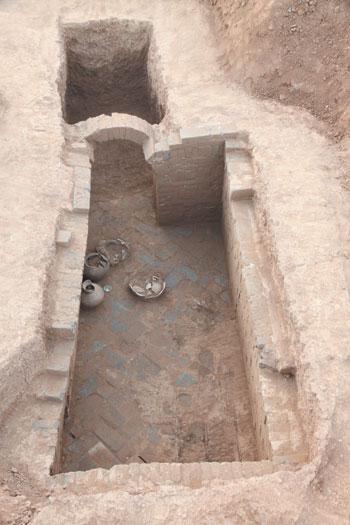Chinese Institute of Archaeology
Source - http://www.kaogu.cn/en/detail.asp?ProductID=4004
Incorporating with infrastructure projects, personnel from Jinan Municipal Archaeological Institute have conducted an excavation to the Yujiabu cemetery in Zhangqiu from November to December in 2012. Totally 17 tombs have been found, including earth shaft tombs, earth shaft tombs with a brick-built outer coffin, brick-chamber tombs and earth pit tomb with cave chamber. Among them the cave-chamber tombs are from Qing Dynasty, and all other types belong to Han Dynasty.

There are 6 earth shaft tombs. Their forms are relative simple. Some of them have a funerary box to contain burial objects. Burial objects include a pair of ceramic jars, some coins (mainly Wuzhu coins, with the exception that Tomb M8 yields only Daquan wushi coins). In some tombs bronze mirrors and buckle hookers are found. In Tomb M6 a great deal of shards and tile fragments are buried in the bottom of chamber and at the lower part of the filling earth. In Tomb M7, the lower part at the south and north sides neatly buried many pebbles. In light to tomb forms and burial objects, the tombs could be dated back to mid- and late West Han to early East Han period. Some tombs probably are from Wang Mang period.
There are 4 earth shaft tombs with a brick-built outer coffin. The bottom of the chamber is paved with bricks, which are arranged with two patterns, and chamber wall bricks, with three patterns. On most brick chamber ceilings remain traces of a wooden cover. Burial objects include a pair of ceramic jars and some coins (Tomb M3 Daquan wushi coins). Some tombs contain bronze mirrors. The tomb forms and burial objects point them to the Wang Mang period.
There are 5 brick-chamber tombs, all with a passage. Some have the ante- and rear- chambers, and some have only a single chamber. All of them are destroyed. The ground is paved with bricks arranged with zigzag pattern, and the wall built with bricks arranged with two different patterns. The ceilings of the tombs are all broken. Burial objects include gray and white ceramic jars, bronze mirrors and coins. The tomb shapes and burials objects point these tombs to the East Han period.

There are 2 earth pit tomb with cave chamber. All possess a niche in the wall. Burial objects are porcelain bowls, lamps, jars, bronze coins and hairpins.
A unique phenomenon is that in Tombs M3 and M6 the human skeletons are not found in the coffins but at the northwest corner of the shafts, which are both put upside down, suggesting that the two tombs have been robbed soon after they were built.
The tombs are all made in small size. Their forms and burial objects show no difference with the previous found Han and Qing dynasties tombs in Jinan region. The most notable points go as following: First, Tomb M3 and M6 contain inverted human skeletons, which is very rare among previous findings. Second, the tombs containing a great deal of tile fragments, shards as well as the white ceramic jars unearthed from Tomb M13 are quite rare among Han tombs in Jinan region. Third, Tombs M3, M8 and other tombs yield Daquan wushi coins, telling explicitly that the tomb’s dating is the Wang Mang period. The tomb forms and burial objects are also helpful to give a date to all other tombs in the region. Therefore, the excavation to these tombs provides important materials for studying Han tombs in Jinan region. (Translator: Tong Tao)